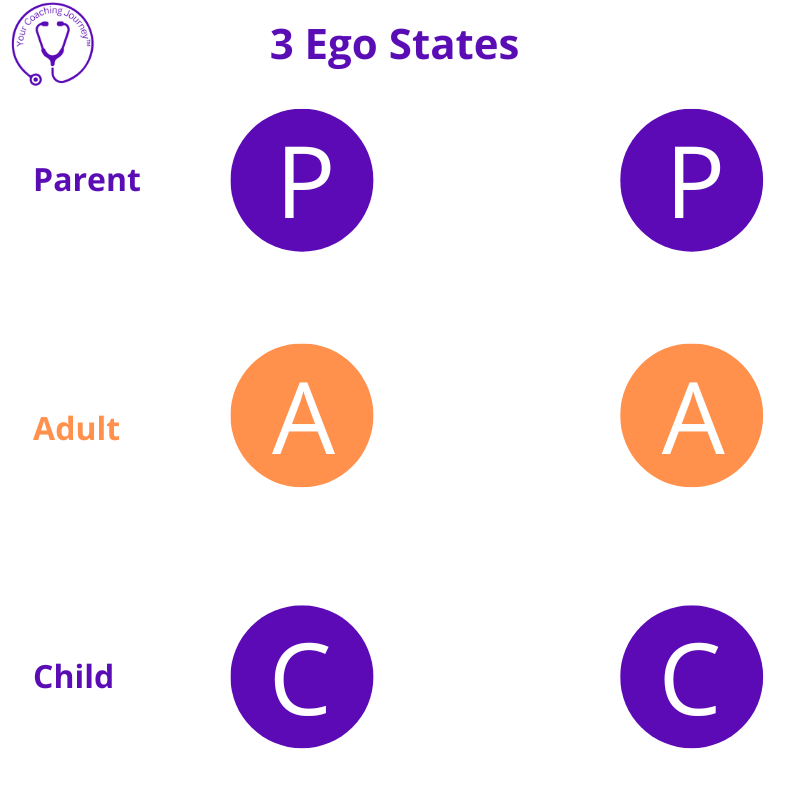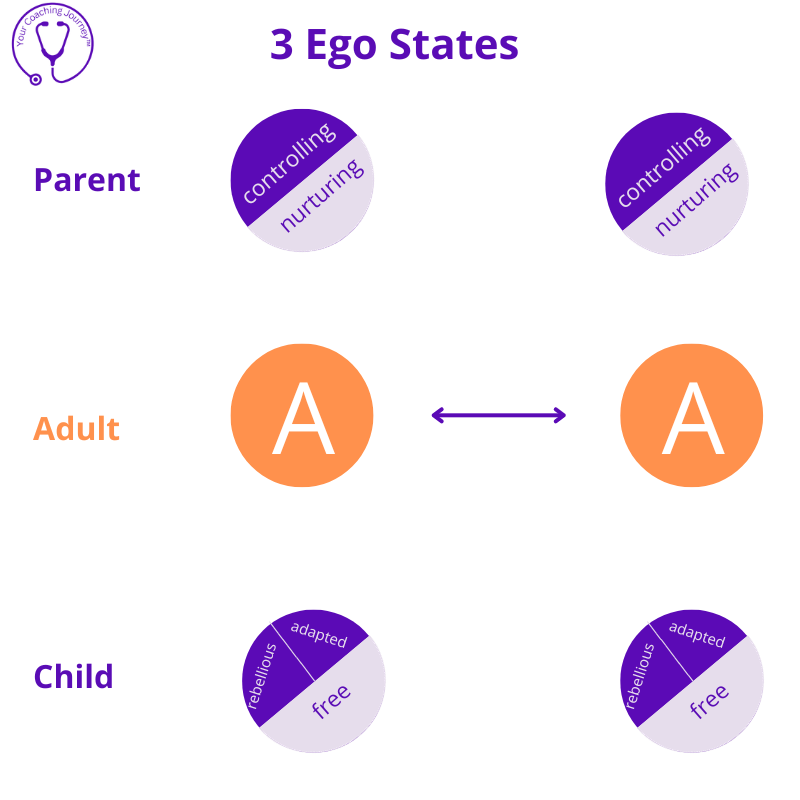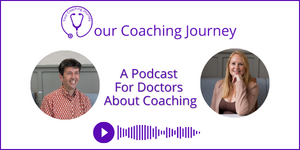Prefer to listen?
This blog post forms the basis of our podcast on this model, which you can listen to here.
Exploring The Parent – Adult – Child Model In Coaching
This is a model that comes from Transactional Analysis (TA).
The transaction part of transactional analysis, is about the transactions or interactions between people.
Eric Byrne was of the idea that each time we come into contact with someone else, there is some form of transaction going on: We will want our needs met. They will want their needs met. Hopefully, somewhere along the line, someone gets their needs met. But there is that sort of transaction happening all the time.
If we look at the visual for this model, there are two traffic lights (each representing a person) alongside each other, side by side, both with parent, adult, and child in. And it’s about how these two interact. So the parent might be talking to the parent, the adult might be talking to the adult, the child might be talking to the child, but then the parent might be talking to the child, the adult might be talking to the parent.

Within organisations and within most relationships what we’re aiming for, for the most part, is adult to adult communication. It’s not always the case that adult to adult communication is happening, and there will be times when we will stray into one of the other modes.

As we covered in our blog on Transactional Analysis, these ego states are things that we learned in our childhood. So, the parent in the model, the parent ego state, is what we saw in our parents and caregivers, other significant adults in our life. We saw them behave in a certain way, and that gave us our model of what the parent ego state looks like.
The parent state is split between controlling parent and nurturing parent:
We will have seen controlling parents where they have set rules, and if you don’t follow the rules, there are consequences. And obviously, as a parent, you want to have some control over children. They need to be kept in check, because otherwise they do dangerous things. They might run across the road, and we need some rules about that.
At the same time, they will also be doing a lot of nurturing parent. They’re there to look after us. Picking us up when we fall down, tying our shoelaces when we are little.
So we will learn all of that as it’s demonstrated to us as children growing up. We learn that’s what parents are like, and that’s how you behave as an adult.
As a child, we’re taking all this in and we are responding to that. We’re having to navigate that space. So if we have a family home and we’ve got a controlling parent and a nurturing parent, let’s say we got one of each. We will adapt our way of being around the controlling parent. It might be different to how we are around the nurturing parent. We will learn to navigate that space, and we will learn what gets rewarded from one parent and what gets rewarded from the other. So we’ll become quite adept at getting what we need as a child from each of those parents and staying safe as a child with each of those parents.
In our model, we have the adapted child, which knows the rules: there are some rules in this household, and I have to follow the rules, otherwise things happen, I’m in trouble. So we learn to know and follow rules.
Or if we have a temperament that doesn’t like following the rules all of the time, that adapted child gets split out and it becomes a rebellious child. We’re still in that adapted space that we know the rules, but we’re choosing not to follow the rules and we rebel.
And there are times when there are no rules. So if we’re out playing with our friends or the parents aren’t around, we might well be in free child. There might be times with our parents when we’re in free child, playing around with them, having fun. We learn how to be a free child.
That’s the parent adult child model, like a traffic light model. And it comes into its own when you’ve got two ‘traffic lights’ talking to one another and you can see the interactions playing out.
Transactions That Might Play Out In Our Interactions With Others
Complementary Transactions
In an organisation, we will perhaps have stereotypical role model of the boss with a command and control leadership style, which is the controlling parent: ‘You do what I say, otherwise you’re out the door’.
Most forward thinking leadership teaching is different to that. And there is a combination of nurturing and asking people what they think. A bit more of a coaching style of leadership. But inevitably, within any organisation, you are going to come across some people who have that controlling style. And it’s useful to think about the controlling parent as their style if that’s how they show up. And if you treat people like children, they tend to behave like children. If we imagine those two traffic lights, the boss coming from the top ‘parent’ traffic light, talking to the bottom ‘child’ traffic light. Within Transactional Analysis, that’s considered to be a complementary transaction and that can go on for a lifetime.
If you think about a marriage where you’ve got someone who’s a controlling parent and then someone that perhaps shows up in the relationship as an adapted child: “okay, no, that’s fine, you make the rules, I’ll just do what you want to do”. That could go on for a lifetime.
In the workplace, and in relationships, it can work, and continue for a long time, but it’s not healthy, or an ideal scenario.
Ideally, we want to be interacting in an adult to adult way.
You might have two controlling parents collaborating against someone else if you’ve got two colleagues be discussing someone saying ‘she’s a nightmare’, ‘Yes, She is. We need to tell her what to do’.
You might have child to child collaborations; if the boss is away for a week, they might collude and decide they could bring a TV and watch the football whilst he’s away. That could be a rebellious child state to be in. Or it could be free child of, “oh, well, let’s just go to the pub. We don’t need to work”.
Cross Transactions
We might have cross transactions where two controlling parents are talking to each other, but talking down to each other as though they are children. Perhaps someone who said, ‘well, it’s my way or the highway’. And the other person saying, ‘don’t you talk to me like that’. This type of interaction is not going to end well and it’s not sustainable over time.
Let’s Think About The Coaching Room
If someone is telling us about something dramatic has happened, that tends to be the result of a cross transaction. But more often than not within the coaching room, we’ll see the complementary transactions being played out in some way and people will come and say, ‘this is happening and I don’t really understand it’.
It might be that they’re coming from a controlling parent and can’t understand why people aren’t very happy with their style. They might have had 360 feedback where people said, ‘he’s got a strange communication style’, which might just mean he’s a bit aggressive in the way he talks to people.
It might be that see clients who are just overwhelmed, they’ve got too much to do, and we recognise that they’re being a nurturing parent and they’re taking on all the work have become overwhelmed. That’s a big problem. When the ‘child’ can’t cope with everything, they will repeatedly be going to the ‘nurturing parent’, knowing that they will step in.
If someone is showing up with this issue, perhaps it would be useful to explore this model with them, and then ask them how they can think about it as an adult, have some boundaries, and communicate with the other person as an adult and asking, ‘how do we solve this together?’
In a coaching session, when relationship interactions are involved, it’s most certainly useful to explore this model. We can simply draw six circles or two sets of traffic lights, and then draw lines between them and explain that we’re looking for this adult to adult communication. We can ask them “What do you think is going on in this scenario?” And most people will see it. If they’re the nurturing parent, they will say, “yes, that’s me. But I am nurturing. That’s who I am”. Which is fine up to a point, but not if you’re overwhelmed because you’re taking on everyone else’s work.
If they’re the controlling parent, again, they’ll see it and say something like “yeah, I’m doing that thing, aren’t I? I’m being the parent.” You might get some controlling parents who say that they have to do that because their team are like kids and they can’t do anything. But it’s disempowering for people to be treated like children. They will end up behaving like children. Whereas if you start to have adult to adult conversations, you have much better dialogue and give them the autonomy to take responsiblity for their role and to move into that adult space.
Asking the coachee how they see their situation in relation to this model is really important so that they gain perspective, and we stay nondirectional. We also don’t want to be going into controlling parent or even nurturing parent ourselves. So we’re drawing out the model, but we’re not drawing out their situation. We’re asking them for how they now see it, given their new knowledge of this model.
It’s also interesting to explore where the behaviours and tendencies come from. Where have they learned that that’s how you behave as an adult in a situation of responsibility? It could be that they had a controlling parent growing up or they had a very authoritarian teacher or headmaster.
There will be someone somewhere where they’ve learned that style of behaviour from, typically in childhood. Both parent states are what we saw modelled by those adult figures around us. And we drag that through with us into our adult world. And the child ego state is how we learn to navigate that space in that environment growing up. How do I keep myself safe? How do I get what I want? How do I navigate these strange beings that are parents? But a better way to be, a more mature way to be, would be to find a way to be an adult.
The more that we can stay in that adult space, whether it’s in our personal relationships or in our workplace, the better we will be at maintaining those adult relationships and having harmonious interactions.
It may be as a coach you that you have to meet a coachee where they are and they are in a child state. They’re coming to you and say, “this is a horrible situation. I can’t do anything about this. I’m helpless in this situation”. And you might have to be the nurturing parent initially in your first interaction and make comforting sounds and say “okay, well, we’ll work through it together”. But don’t stay there, you can then help to raise them to the adult ego state by asking them really good questions that help them to gain perspective. In the coaching room, we don’t want to be having a parent to child conversation, either controlling or nurturing. We want to have adult to adult conversations throughout our coaching. After all, coaching is designed to encourage autonomy in the coachee and to allow them to feel empowered to be the adult, to make those decisions, to explore their thinking rather than be told what their thinking is.
This is a really useful model to be able to bring to people’s attention, it will help them to take a look at it and see where they are with it, and how they might change that dynamic so that they can perhaps have more adult to adult conversations with the people they’re working or living with.
Transactional Analysis in Coaching is just one approach to coaching that is covered on out Doctors’ Transformational Coaching Diploma.
This blog post forms the basis of our podcast on Transactional analysis, which you can listen to here.




